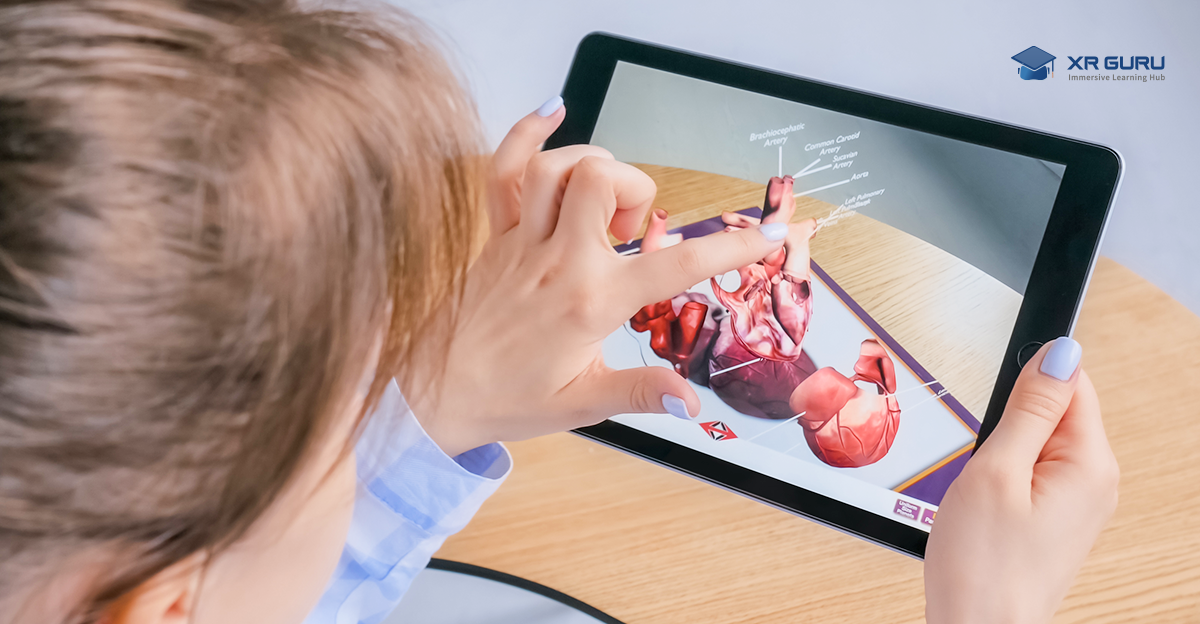Augmented reality (AR) and Virtual Reality (VR) are becoming prominent technologies in diverse fields, and they are no longer mere tools employed to enhance the entertainment industry. Multimedia, tech-based education is gaining popularity among educators, and AR/VR is unquestionably creating a buzz in the EdTech industry. The healthcare sector has been quick to realize the potential of leading-edge technologies like AR/VR and have started incorporating them in medical teaching. According to a study by Global Market Insights, the value of the AR/VR healthcare market was $1.9 billion in 2020 and is projected to surpass $16.2 billion by 2027, growing at a Compound Annual Growth Rate (CAGR) of more than 35.8% between 2021 and 2027. They predict the widespread adoption of AR/VR for medical training will drive the market progression. In this blog, we will explore how virtual and augmented reality for training can be of use in the healthcare industry and how it can help future healthcare professionals.
Practicing Surgery
In most professions, reading from textbooks, watching lecture videos, and presentations are not enough. People need hands-on practice to excel in their field of work, and surgeons are no exception. Medical students need years of training before they can pick up the scalpel and become surgeons. But, practicing with real-life patients involves a greater level of risk; one wrong move can cause critical harm, so patients refuse to participate. Practicing on cadavers can improve accuracy, but cadavers cannot mirror the experience of operating on a real person. Fortunately, we live in an era where medical students can hone their skills without harming anyone through virtual/augmented reality training. By superimposing images on a mannequin, AR offers a realistic experience of performing surgery on a living person.
With AR/VR simulations, learners can practice multiple times and learn from their mistakes without worrying about the consequences.
Remote Assistance for Trainees
You no longer need to wait for experts to travel to your location to instruct your personnel. Using virtual and augmented reality, you can avail expert assistance in an instant. With AR/VR equipment, the experts can 'see what you are seeing,' help diagnose the issue, and offer instructions on the operating procedure without having to set foot in a hospital or clinic.
This can be of great help during critical operations as the expert can give instructions on how to treat the patient from a remote location.
Emergency Response Training
When it comes to accidents in remote locations, highways, or other emergencies, there may not be a hospital or qualified doctor close by to immediately treat the victims. In such cases, paramedics, firefighters, police officers, or other personnel will have to perform life-saving activities without delay to save human life. So, these responders need to be well trained to efficiently perform CPR, treat burns, frostbites, treat wounds, etc. Using VR and AR applications for training, we can simulate life-like scenarios to train these volunteers and help them practice and become well-versed and highly effective in performing first-aid activities.
Learning Anatomy with AR/VR
Using AR/VR to teach anatomy is becoming increasingly popular among medical schools. Augmented/virtual reality based learning can displace cadavers and plastic models to teach human anatomy. In traditional education, students can often have a hard time visualizing the human anatomy from 2D images. However, using AR/VR learning systems, learners can easily visualize and understand the human body with interactive 3D image projections and 'take apart' each body part to examine it individually.
Advantages of Using AR/VR in Healthcare Training
There are several benefits of using AR/VR in healthcare education, and some of them are as follows:
- Real-life Experience: AR/VR offers a life-like experience with engaging 3D simulations and projections that help students understand the functioning of the human body faster and better retain information.
- Cost-effective: The cost of building AR/VR apps and VR equipment, though not cheap, is relatively inexpensive compared to the costs of setting up an anatomy lab and providing cadavers for students to practice.
- Low risk: Compared to traditional training methods and operating on real-life patients, incorporating virtual and augmented reality in the training process is much safer and low risk, so it bolsters the confidence of the trainees to sharpen their skills.
- Better Retention Rates: Compared to conventional training methods, training with visuals can help students remember the information for a longer period. In fact, a study shows training with immersive technologies like VR/AR has a retention rate of 75%, compared to 5% for lecture-style education and 10% if the same information was read.
Concluding Thoughts
Gone are the days of on-job training. By using immersive technologies like virtual and augmented reality for training, healthcare professionals can start the job with essential knowledge. AR/VR can help medical students perfect their skills, and help others learn first aid and other life-saving techniques.
Curious about incorporating virtual and augmented reality for training? XR Guru is an immersive learning hub that combines virtual and augmented reality technologies to make training interactive, engaging, easy, and fun. With XR Guru, you can facilitate immersive training by simulating real-life scenarios.
Get in touch with us for a free consultation on your virtual/augmented reality training needs
Claim Your Free Consultation

